Kostarika |
|
|
|
| Übersicht – Contents: | |
Kostarika |
|
|
|
| Übersicht – Contents: | |
Flaggen – Flags: |
|
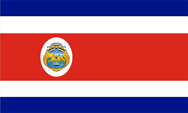 |
National-, Staats- und Marineflagge – national, state and naval flag, Seitenverhältnis – ratio = 3:5, Quelle/Source, nach/by: Wikipedia (D)   |
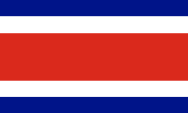 |
Handelsflagge – merchant flag, Seitenverhältnis – ratio = 3:5, Quelle/Source, nach/by: Wikipedia (D)   |
historische Flaggen – historical Flags: |
|
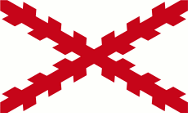 |
1538–1717, Flagge Königreich Neu-Spanien – flag of the Kingdom of New Spain, Quelle/Source, nach/by: Wikipedia (ES) |
 |
1717–1785, Flagge Vize-Königreich Neu-Granada – flag of the Vice-Kingdom of New Granada, Quelle/Source, nach/by: Wikipedia (EN) |
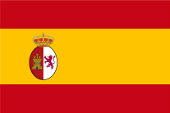 |
1785–1821, Flagge Vize-Königreich Neu-Spanien – flag of the Vice-Kingdom of New Spain, Quelle/Source, nach/by: World Statesmen |
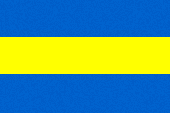 |
1821–1822, |
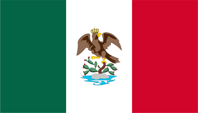 |
1822–1823, |
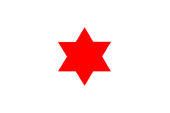 |
05.10.1823–04.03.1824, |
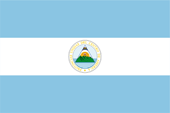 |
04.03.1824–02.11.1824, |
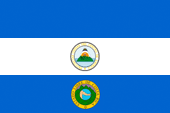 |
02.11.1824–22.11.1824, Flagge der der Zentralamerikanischen Konföderation ergänzt um das Emblem Kostarikas – flag of the Central American Confederation added by the emblem of Costa Rica, Quelle/Source, nach/by: Wikipedia (D) |
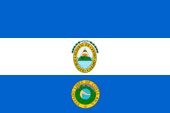 |
22.11.1824–15.11.1840, Flagge der der Zentralamerikanischen Konföderation ergänzt um das Emblem Kostarikas – flag of the Central American Confederation added by the emblem of Costa Rica, Quelle/Source, nach/by: Wikipedia (D) |
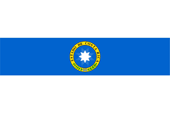 |
21.04.1840–20.04.1842, Nationalflagge – national flag, Seitenverhältnis – ratio = 2:3, Quelle/Source, nach/by: Wikipedia (D) |
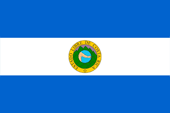 |
Sept. 1842–12.11.1848, |
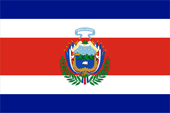 |
29.09.1848–27.11.1906, |
Bedeutung/Ursprung der Flagge – Meaning/Origin of the Flag: |
|
| Die
Flagge Kostarikas zeigt seit 1848 fünf waagerechte Streifen in den Farben
Blau, Weiß, Rot, Weiß und Blau im Verhältnis 1:1:2:1:1. Die heutige Flagge Kostarikas wurde im Jahre 1906 aus Anlass der Annahme eines neuen Wappens eingeführt. Das neue Wappen wurde wesentlich verkleinert und in einem weißen Oval innerhalb des roten Mittelstreifens nahe des Flaggenmastes positioniert. Am 21.10.1964 wurde das Wappen geringfügig verändert, indem die Anzahl der Sterne im Wappen von fünf auf sieben erhöht wurde. Die Farben Blau und Rot sind unter anderem in Pantone PMS definiert, als Blau = Pantone Reflex Blue und Rot = Pantone 485. |
The flag
of Costa Rica shows since 1848 five horizontally stripes in the colours
blue, white, red, white and blue in the proportion 1:1:2:1:1. The today's flag of Costa Rica was introduced in the year 1906 on occasion of the adoption of a new coat of arms. The new coat of arms became appreciably minimized and positioned in a white oval within the red middle stripe near the flagstaff. On 21st of October in 1964 the coat of arms was slightly changed by increasing the number of stars in the coat of arms from five to seven. The colours blue and red are defined, among others, in Pantone PMS, as blue = Pantone Reflex Blue and red = Pantone 485. |
| In Kostarika ist es Privatpersonen per Gesetz verboten die Nationalflagge zu verwenden. Es sind nur Wimpel und Bänder in den Landesfarben gestattet. Dennoch wird doch häufig die Handelsflagge gehisst. Sie trägt kein Staatswappen. | In Costa
Rica is it private persons forbidden by law to use the national flag. There
is only permitted to use pennants and ribbons in the colours of the country. Nevertheless is frequently in use the merchant flag. It carrys no coat of arms. |
| Im Jahre 1821 wurde Kostarika von Spanien unabhängig. Die erste eigene Flagge war eine horizontal dreigestreifte Flagge in den Farben Blau, Gelb und Blau. Wahrscheinlich sollte damit die Lage der "reichen Küste" (= Costa Rica) zwischen den Ozeanen dargestellt werden. | In the year 1821 Costa Rica became independent from Spain. The first own flag was a horizontally threefold striped flag in the colours blue, yellow and blue. Probably should be symbolized with this design the position of the "rich coast" (= Costa Rica) between the oceans. |
| Bereits 1823 wurde eine neue Flagge angenommen, obwohl Kostarika zum Kaiserreich Mexiko gehörte. Sie zeigte ein weißes Flaggentuch mit einem sechszackigen roten Stern in der Mitte. | Already in 1823 was adoped a new flag, though Costa Rica belonged to the Empire of Mexico. It showed a white bunting with a six-pointed red star in the middle. |
| Kostarika war ab 1824 Mitglied der Zentralamerikanischen Föderation und führte ab März deren Flagge, wobei als Besonderheit ab November ein eigenes Landeswappen unterhalb des Wappens der Föderation geführt wurde. Als Kostarika im Jahre 1838 die Föderation verließ, wurde die Föderationsflagge dennoch bis 1848 beibehalten, außer zwischen 1840 und 1842 als eine Flagge in farblicher Umkehrung verwendet wurde. (→ Zentralamerikanische Föderation) | Costa
Rica was since 1824 a member of the Central American Confederation and used
since March its flag, but from November was in use as a characteristic an
own coat of arms below the coat of arms of the federation. As Costa Rica in the year 1838 left the federation, nevertheless was maintained the flag of the federation until 1848, except between 1840 and 1842 as there was in use a flag in inversion of colours (→ Central American Confederation). |
| Als im Jahre 1848 der König von Frankreich Louis-Philippe von Orléans gestürzt wurde und ganz Europa in einen revolutiuonären Taumel geriet, empfahl auch die Frau des damaligen Präsidenten von Kostarika die Landesflagge um einen zentralen, breiten, roten Mittelstreifen zu ergänzen, damit die Flagge in den Farben Frankreichs erscheine. Am 29.09.1848 wurde diese neue Flagge angenommen, ergänzt um das neugestaltete Wappen. | As in
1848 the King of France Louis-Philippe of Orléans was unseated and whole
Europe fell in a revolutiuonar frenzy, the wife of the then President of
Costa Rica also advised to add the flag of the country by a central, broad,
red middle stripe, because the flag should appear in the colours of France. This new flag was adoped on the 29th of September in 1848, completed by the new designed coat of arms. |
|
Quelle/Source: Die Welt der Flaggen, Flaggen Wappen Hymnen, Flaggen und Wappen der Welt, Wikipedia (D), Wikipedia (EN) |
|
Dunkelblau oder Hellblau – Dark blue or light blue: |
|
| Die heutigen Flaggen der Staaten Mittelamerikas gehen alle auf die Flagge der Zentralamerikanischen Föderation zurück. Auf dieses Merkmal wird bei jeder einzelnen Flagge jedes einzelnen mittelamerikanischen Staates besonders hingewiesen und in Nikaragua sagt man sogar, dass man die Flagge der Föderation im Prinzip bis heute fortsetze. Nur wie kommt es von Staat zu Staat zu so unterschiedlichen blauen Farbtönen, mal heller, mal dunkler? | Today's flags of the states of Central America all date back to the flag of the Central American Federation. This feature is particularly pointed out in every single flag of each Central American country, and in Nicaragua it is even said that the flag of the Federation is in principle continued until today. But where is the reason for all these blue tones which vary from country to country, sometimes lighter, sometimes darker? |
| Das Problem dabei ist, dass Flaggen als historische Fundstücke mit dem modernen Auge betrachtet werden, und schnell eine bestimmte Farbbezeichnung verpasst bekommen. Stichwort "Hellblau"; dabei völlig ignorierend, dass das Hellblau mit sehr hoher Wahrscheinlichkeit auf Auswaschen und Verbleichen zurückzuführen ist, eine bei Indigo (Waid) bis heute bekannte, gewollte und entsprechend ausgenutzte Eigenschaft. Noch schlimmer wird es, wenn das Hellblau angeblich ein ganz bestimmtes gewesen sein soll. | The
problem is that flags as historical finds are seen with the modern eye,
and quickly is a certain colour fixed – Keyword "light blue" –
completely ignoring the fact that the reason for the light blue is very
likely to be due to washing out and bleaching, an attribute known for
Indigo dye (woad) until today, intented and appropriately exploited. It gets even worse if the light blue is supposed to have been a very specific one. |
| Beim Färben von Textilien kamen verschiedene Färbepflanzen zum Einsatz. Allerdings hatte das Blau, je nachdem welche Färbepflanze man verwendet hat, eine andere Färbung. Das konnten sein: Waid (für ein mittleres Blau) später auch Indigo, Holunderbeeren (für Rot-violett), Ritterspornblüten und Rotkraut (für Türkis), Alkanna und Blauholz (für Violett). Dass es so zu sehr unterschiedlichen Farbtönen kommt, ist gerade bei Blau absolut offensichtlich. Es wird klar, dass vor dem Zeitalter der Industrialisierung, mit seinen chemischen Möglichkeiten, kaum Standards erreicht werden konnten, und es ist leicht nachvollziehbar, warum bei Blau so viele Farbschattierungen auftauchten. Erschwerend kommt noch hinzu, dass es kaum Möglichkeiten gab, die Farben langanhaltend zu fixieren, so dass schon nach kurzer Zeit ein Auswaschen und Verbleichen zu sehen war. | Different dyeing
plants were used for dyeing textiles. However, the blue had a different
colour depending on which dyeing plant was used. These could be: woad (for a medium blue), later indigo, elderberries (for red-violet), delphinium and red cabbage (for turquoise), alkanna and bluewood (for violet). Therefore it is absolutely obvious that it would come to very different shades, especially for the colour blue. It is clear that, before the age of industrialisation with its chemical capabilities, few standards could be achieved, and it is easy to understand why so many colour-shades appeared in blue. To make matters worse, there were hardly any possibilities to set the colours for a long time, so that after a short time washing out and fading was apparent. |
| Das Hellblau der historischen Flaggen muss von daher zuerst als in Kauf zu nehmender und in Kauf genommener Nebeneffekt gesehen werden und nicht als Absicht. Die Heraldik kannte kein Hellblau oder Dunkelblau. Blau war Blau, egal wie es aussah. Mögen die Farbtöne für heutige Flaggen auch präzise festgelegt sein, für historische Flaggen kann das nicht zutreffen. Von daher wurde hier für die Darstellung des Blautons bei historischen Flagge ein einheitliches "Mittelblau" verwendet. | The light blue of
the historic flags must therefore first be seen as a side effect which is to
be accepted, and has been accepted, and not as an intent. The heraldry knew
no light blue or dark blue. Blue was blue, no matter what it looked like.
Although the colour tones for today's flags may be precisely defined,
this is not true for historical flags. Therefore, a uniform "middle blue" was used here for the representation of the blue tone on a historical flag. |
|
Quelle/Source: Volker Preuß |
|
Wappen – Coat of Arms: |
|
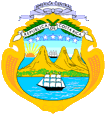 |
Wappen von Kostarika – coat of arms of Costa Rica, Quelle/Source: Corel Draw 4 |
Bedeutung/Ursprung des Wappens – Meaning/Origin of the Coat of Arms: |
|
| Das heutige Staatswappen von Kostarika wurde 1848 eingeführt und mehrfach geändert, so 1906 und zuletzt 1964. Es zeigt drei Vulkane auf einem schmalen Festlandsstreifen zwischen zwei Meeren, auf denen je ein Segelschiff fährt. Am Himmel sieben Sterne in einer Reihe. Die Vulkane symbolisieren die Landbrücke zwischen Nord- und Südamerika, die Wasserflächen stehen für Atlantik und Pazifik. Die sieben Sterne stehen für die sieben Provinzen von Kostarika. Bis 1964 waren es nur fünf Sterne, die jedoch die Mitgliedstaaten der Zentralamerikanischen Konföderation symbolisierten. Das Wappen von Kostarika erinnert entfernt an das Wappen der Zentralamerikanischen Konföderation. | The
today's coat of arms of Costa Rica was introduced in 1848 and changed
anytimes, so in 1906 and finally in 1964. It shows three volcanos on a
narrow isthmus between two oceans, on whom rides ever one sailing ship. In
the heaven seven stars in a line. The volcanos symbolize the landmass-bridge
between North and South America, the water surfaces stand for Atlantic and
Pacific. The seven stars stand for the seven provinces of Costa Rica. Until
1964 there were only five star, which however symbolized the membering
states of the Central American Confederation. The coat of arms of Costa Rica
remembers far for the coat of arms of the Central American Confederation. |
| Quelle/Source: Flaggen Wappen Hymnen | |
Flugzeugkokarde – aircraft roundel: |
|
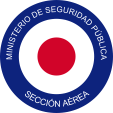 |
1964–1994, Flugzeugkokarde – aircraft roundel Quelle/Source: nach/by Wikipedia (EN), F l a n k e r [Public domain], via Wikimedia Commons |
Landkarten – Maps: |
Die Lage des Landes – position of the Country: |
Landkarte des Landes – Map of the Country: |
|
|
Zahlen und Fakten – Numbers and Facts: |
|
|
|
|
|
|
|
|
|
|
|
|
|
|
|
|
|
|
|
Geschichte: |
| 1502 ·
Entdeckung der Ostküste des heutigen Kostarikas durch Christoph Kolumbus 1522 · Entdeckung der Westküste des heutigen Kostarikas durch den Spanischen Seefahrer de Avila 1524 · Erkundung des Landes durch den Spanier Juan Vázquez de Coronado, Gründung der ersten spanischen Siedlung, in der Folgezeit Kolonisierung durch Spanien 1535 · Errichtung des Vizekönigreiches Neuspanien, dem Mittelamerika (und damit als Teilprovinz auch das heutige Kostarika) als "Generalkapitanat Guatemala" angeschlossen wird 1560 · die Erkundung und Kolonisierung des Landes durch Spanien ist abgeschlossen 1731 · Gründung von San José 29.10.1821 · Proklamation der Unabhängigkeit Januar 1822 · Kostarika schließt sich dem Kaiserreich Mexiko an 1823 · nach dem Sturz des mexikanischen Kaisers wird die Verbindung zu Mexiko gelöst, und die Staaten des ehemaligen Generalkapitanats Guatemala verbinden sich zu den "Vereinigten Provinzen von Mittelamerika" (Zentralamerikanische Konföderation) 1838 · Kostarika verläst die Zentralamerikanische Konföderation 1843–1847 · instabile Regierungen, häufige Wechsel 1848 · neue Verfassung 1917 · Militärputsch des Verteidigungsministers Tinoco 1919 · US-amerikanische Militärintervention, Gegenputsch 1944 · Beilegung der Grenzprobleme mit den Nachbarstaaten 1948 · umstrittener Wahlausgang, Bürgerkrieg, Regierung unter José Ferrer, neue Verfassung 1949 · Abschaffung der Armee durch José Ferrer, Umwandlung in eine 7.500 Mann starke Bürgerwehr, um Polizeikräfte ergänzt 1983 · Kostarika proklamiert einen strikten Neutralitätsstatus Juli 1998 · Auseinandersetzungen mit Nikaragua am Grenzfluß San Juan |
History: |
| 1502 ·
discovery of the eastern coast of the today's Costa Rica by Christoph
Columbus 1522 · discovery of the western coast of the today's Costa Rica by the Spanish seafarer de Avila 1524 · exploration of the country by the Spaniard Juan Vázquez de Coronado, foundation of the first Spanish housing estate, in the afteryears colonization by Spain 1535 · establishment of the Vice Kingdom of New Spain, which affiliates whole Central America (and therewith as a partial province even the today's Costa Rica) as "General Capitanate of Guatemala" 1560 · the exploration and colonization of the country by Spain is completed 1731 · foundation of San José 29.10.1821 · proclamation of the independence Januar 1822 · Costa Rica joines the Empire of Mexico 1823 · after the overthrow of the Mexican emperor gets the connexion to Mexico untied, and the states of the former General Capitanate of Guatemala combine to the "United Provinces of Central America" (Central American Confederation) 1838 · Costa Rica leaves the Central American Confederation 1843–1847 · unstable governments, frequent changes 1848 · new constitution 1917 · military coup d'état of the Minister of Defence Tinoco 1919 · US-American military intervention, counter coup d'état 1944 · termination of the border's problems with the neighbouring countries 1948 · disputed electional result, civil war, government under José Ferrer, new constitution 1949 · abolition of the army by José Ferrer, transformation into a 7.500 man potent militia, added by police forces 1983 · Costa Rica proclaims a strict status of neutrality Juli 1998 · quarrels with Nicaragua near the border-river San Juan |
| Quelle/Source: Atlas zur Geschichte, Wikipedia (D), Discovery '97, Weltgeschichte |
Ursprung des Landesnamens – Origin of the Country's Name: |
|
| Der Name Kostarika hat seinen Ursprung in der spanischen Wortgruppe "Costa Rica", was "reiche Küste" bedeutet. Der Name wurde der Ostküste dieses Landes durch Christoph Kolumbus verliehen, da er hier im Jahre 1502 Eingeborene mit üppigem Goldschmuck antraf. Dieser Name wurde im Lauf der Zeit für das ganze dahinter liegende Land übernommen. | The name
Costa Rica is from Spanish origin and means "rich coast". The name was awarded the eastern coast of this country by Christoph Columbus, because he found here in the year 1502 natives with abundant golden jewelries. This name was taken over in the times for the whole behind situated country. |
| Quelle/Source: Handbuch der geographischen Namen | |